2. 兰州铁道设计院有限公司, 兰州 730000
2. Lanzhou Railway Design Institute Company Limited, Lanzhou 730000, China
厌氧氨氧化(anaerobic ammonium oxidation, ANAMMOX)工艺是指以NO2--N为电子受体, 以NH4+-N为电子供体直接反应生成氮气[1~3], 其计量学方程如式(1).与传统的硝化-反硝化工艺相比, ANAMMOX工艺具有能耗低、脱氮效率高及污泥产量低等优点, 成为最有前景的工艺之一[4~7].然而在厌氧氨氧化反应过程中, 约11%的TN(NH4+和NO2-)转变为NO3--N, 导致TN浓度无法达到排放标准[8].

|
(1) |
Tsushima等的[9]研究发现进水基质比(NO2--N/NH4+-N)为0.8~0.87时, 系统TN去除率较高. Jin等的[10]研究表明最佳进水NO2--N/NH4+-N为1.2时出水TN最低.闾刚等[11]的研究发现进水NO2--N/NH4+-N为1.34时厌氧氨氧化脱氮效率较高.陈永等[12]采用进水NO2--N/NH4+-N为1.34时, TN的去除率为87.7%, 过低或过高的进水NO2--N/NH4+-N都会导致NO2--N、NH4+-N的不完全转化.
以上研究主要是在高温(29~35℃)、高基质浓度(NH4+-N浓度100~205 mg ·L-1, NO2--N浓度100~162 mg ·L-1)的人工配水条件下, 考察基质比对厌氧氨氧化脱氮性能的影响, 而采用厌氧氨氧化过程厌氧序批式反应器(ASBR)处理常温低基质实际生活污水同步脱氮除碳的研究还鲜见报道.因此, 本试验在常温(24℃)条件下, 采用SBR处理实际生活污水, 在实现半亚硝化时, 其出水加入定量的NaNO2作为厌氧氨氧化过程厌氧序批式反应器的进水(NH4+-N浓度为28.22~50.52 mg ·L-1, NO2--N浓度为19.92~60.10 mg ·L-1, COD浓度为99.33~148.10 mg ·L-1).本研究利用厌氧氨氧化与异养反硝化的协同作用可实现同步脱氮除碳[13], 以期为厌氧氨氧化工艺处理实际生活污水提供一定的理论指导.
1 材料与方法 1.1 试验装置ASBR反应器采用圆柱形有机玻璃制成(图 1), 直径14 cm, 高45 cm, 有效容积5 L.在其侧壁的垂直方向设置取样口, 底部设有排泥口, 上部设有通气口, 反应产生的气体经水封瓶排出, 为防止光对厌氧氨氧化菌活性的影响, 反应器外侧用黑色塑料布覆盖.
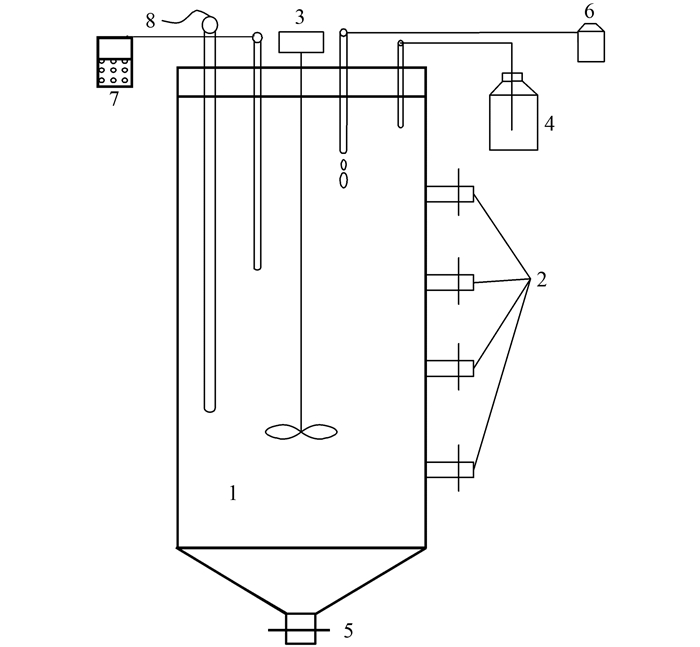
|
1. ASBR反应器, 2.排水口, 3.搅拌器, 4.水封瓶, 5.排泥口, 6.缓冲瓶, 7. pH、ORP检测仪, 8.温控仪 图 1 ASBR反应器示意 Fig. 1 Schematic diagram of ASBR |
本试验采用SBR处理实际生活污水, 当实现半亚硝化时, 其出水加入定量的NaNO2(按需配), 将其作为厌氧氨氧化过程厌氧序批式反应器进水, 实际生活污水水质及厌氧氨氧化进水水质分别见表 1、表 2.试验温度为24℃.
|
|
表 1 生活污水水质/mg ·L-1 Table 1 Quality of domestic wastewater/mg ·L-1 |
|
|
表 2 厌氧氨氧化进水水质/mg ·L-1 Table 2 Quality of influent of AMAMMOX/mg ·L-1 |
从反应器中取100 mL水样, 用定量滤纸过滤, 滤纸残余物在105℃的烘箱内烘至恒重, 冷却后测量MLSS, 然后在600℃的马弗炉内烘至恒重, 冷却后测量MLVSS.水样经过0.45 μm滤纸过滤后根据国家标准方法[14]测定:COD, 快速消解分光光度法; NH4+-N, 纳氏试剂分光光度法; NO2--N, N-(1-萘基)-乙二胺分光光度法; NO3--N, 麝香草酚法; pH和DO采用Multi3420仪测定.
1.3 接种污泥试验污泥取自成功启动的厌氧氨氧化中的活性污泥, 具有良好的脱氮性能, 其MLSS为3270mg ·L-1, VSS为2 550 mg ·L-1.
1.4 计算方法厌氧氨氧化在系统中对脱氮的贡献率A及反硝化在系统中对脱氮的贡献率D的计算, 参考魏思佳等[15]的计算公式; NH4+-N和NO2--N的比降解速率公式参考尤永军[16]的计算公式.

|
式中, (NH4+-N)rem、(NO2--N)rem分别为NH4+-N、NO2--N去除量, mg ·L-1, ΔNO3--N为NO3--N变化量, mg ·L-1.
2 结果与讨论 2.1 不同基质比下氮素的变化特性图 2表示不同基质比条件下氮素的去除特征.阶段Ⅰ(NO2--N/NH4+-N在0.4~1.0之间), NH4+-N出水浓度逐渐减小, 但基本在5.86~25.82 mg ·L-1之间波动, 去除率为57.68%~79.14%, 主要原因是NH4+-N相对NO2--N过量.厌氧氨氧化反应显著特点就是NH4+-N和NO2--N按照一定的比例发生反应, NH4+-N和NO2--N同时作为厌氧氨氧化反应底物, 当NH4+-N相对NO2--N过量时, NH4+-N的去除量由NO2--N控制. NO2--N出水浓度在0.04~5.79 mg ·L-1之间波动. NO3--N进水浓度均低于3.72 mg ·L-1, NO3--N出水浓度在3.90~10.06 mg ·L-1之间波动, 主要是由于COD的存在使得系统内发生反硝化, 导致生成的NO3--N相对较少.阶段Ⅱ(NO2--N/NH4+-N在1.0~1.6之间)时, NH4+-N出水浓度突然减小至5.12 mg ·L-1, 这是因为进水NH4+-N相比阶段Ⅰ较小且进水NO2--N/NH4+-N逐渐地接近理论值1.32[17].当进水NO2--N/NH4+-N为1.4~1.6时, NH4+-N平均出水浓度和平均去除率分别为2.14 mg ·L-1和93.62%. NO2--N出水浓度稳定, 平均出水浓度和去除率分别为1.07mg ·L-1和97.79%, NO3--N平均出水浓度为6.52 mg ·L-1, 此时系统内脱氮性能最佳.
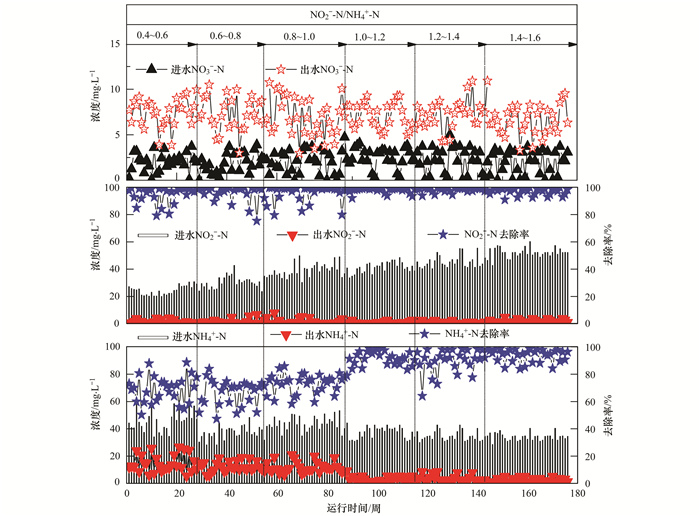
|
图 2 厌氧氨氧化系统中氮素的去除特征 Fig. 2 Nitrogen removal characteristics of ANAMMOX system |
图 3表示厌氧氨氧化系统中TN的去除特征, 进水TN浓度逐渐地增大, 随着运行周期的增加, 出水TN浓度逐渐地减小, 由最开始的20.30 mg ·L-1减小至13.34 mg ·L-1, 去除率由63.12%升至85.88%.周凌等[18]采用低基质人工配水启动厌氧氨氧化反应器时, 发现最佳NO2--N/NH4+-N为1.02, NH4+-N和NO2--N平均去除率分别为94.5%和97.4%.闾刚等[11]采用高基质人工配水, 发现在进水NO2--N/NH4+-N为1.34时, NH4+-N和NO2--N的去除率同时达到99.9%左右.可能是由于在进行厌氧氨氧化的同时伴随着少量反硝化作用或微生物的同化作用, 导致实际需要的NO2--N量大于理论所需, 同时由于污泥浓度存在差异, 导致生物脱氮效率有所不同.安芳娇等[19]的研究采用低基质浓度的人工配水时, 发现进水NO2--N/NH4+-N为1.40时, NH4+-N和NO2--N出水浓度分别为0.8 mg ·L-1和1.5 mg ·L-1, 去除率分别高达96.2%和95.4%.而本试验中系统脱氮效能最好的进水NO2--N/NH4+-N为1.4~1.6, 这主要是因为本试验在有机物的存在下, 厌氧氨氧化反应协同反硝化去除系统中的TN.
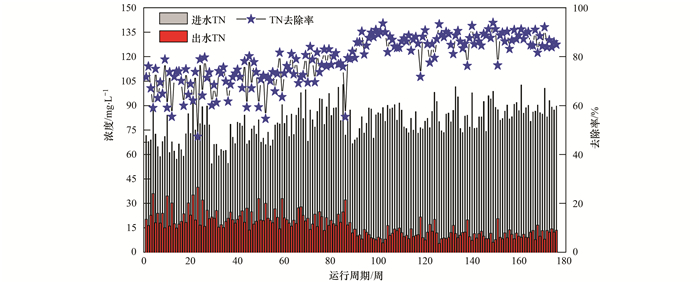
|
图 3 厌氧氨氧化系统中TN的去除特征 Fig. 3 Total nitrogen removal characteristics of ANAMMOX system |
图 4表示不同基质比条件下厌氧氨氧化系统内NH4+-N、NO2--N去除量和NO3--N生成量之比.在阶段Ⅰ, 当进水NO2--N/NH4+-N为0.4~0.6时, ΔNO2--N/ΔNH4+-N平均值为0.74, 较进水NO2--N/NH4+-N高, ΔNO3--N/ΔNH4+-N小于理论值0.26, 这是因为系统在有机物的存在下, 发生了异养反硝化.当NO2--N/NH4+-N为0.6~1.0时, ΔNO2--N/ΔNH4+-N和ΔNO3--N/ΔNH4+-N分别在其理论值附近浮动, 说明厌氧氨氧化与反硝化协同不够稳定.
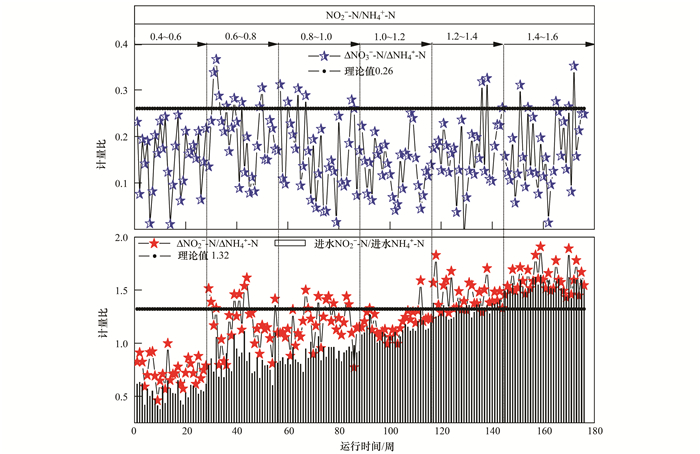
|
图 4 不同基质比下厌氧氨氧化系统内计量比关系 Fig. 4 Stoichiometric ratio relationship of ANAMMOX system under different substrate ratios |
在阶段Ⅱ, 当NO2--N/NH4+-N为1.0~1.2时, ΔNO2--N/ΔNH4+-N平均值为1.19, ΔNO3--N/ΔNH4+-N平均值为0.13, 均比厌氧氨氧化反应的理论值小, 这可能是由于反应系统内存在氨氧化菌(AOB), 把少量的NH4+-N氧化为NO2--N.当NO2--N/NH4+-N为1.2~1.4和1.4~1.6时, ΔNO2--N/ΔNH4+-N平均值分别为1.45和1.60, 均比厌氧氨氧化反应的理论值大, 这是由于系统中存在亚硝酸盐氧化菌(NOB), 将少量的NO2--N氧化成NO3--N; ΔNO3--N/ΔNH4+-N平均值分别为0.16和0.17, 这主要是由于系统内发生厌氧氨氧化的同时发生了异养反硝化, 将生成的NO3--N反硝化为N2或N2 O.
当NO2--N/NH4+-N为1.4~1.6时, 系统内脱氮效能最佳, ΔNO2--N/ΔNH4+-N和ΔNO3--N/ΔNH4+-N平均值分别为1.60和0.17.主要是因为实际生活污水中存在有机碳源, 系统内发生了反硝化, 将产生的NO3--N和发生厌氧氨氧化剩余的NO2--N还原为N2.而李媛[20]的研究发现, 当采用人工配水时, ΔNO2--N/ΔNH4+-N都小于其理论值1.32, 这是因为进水中存在少量的DO, 将部分NH4+-N氧化成NO2--N; 同时ΔNO3--N/ΔNH4+-N的值与理论值0.26也存在偏差, 这可能是因为厌氧氨氧化菌自身繁殖及内源反硝化所致.马斌[21]采用模拟亚硝化出水, ΔNO2--N/ΔNH4+-N和ΔNO3--N/ΔNH4+-N都小于其理论值, 是因为AOB将NH4+-N氧化为NO2--N.
2.3 不同基质比下厌氧氨氧化和异养反硝化对脱氮的贡献率及有机物的去除图 5表示不同基质比下厌氧氨氧化和异养反硝化对脱氮的贡献率及COD的去除.当进水NO2--N/NH4+-N为0.4~0.6时, 厌氧氨氧化在系统中对脱氮的平均贡献率为87.72%, 异养反硝化在系统中对脱氮平均贡献率为12.28%, 该阶段的厌氧氨氧化菌在与反硝化菌竞争基质NO2--N的过程中处于优势.当进水NO2--N/NH4+-N增大至1.4~1.6时, 厌氧氨氧化在系统中对脱氮的平均贡献率减小至58.42%, 异养反硝化在系统中对脱氮平均贡献率增大至41.58%.随着进水NO2--N浓度的逐渐增大, NH4+-N浓度的不足, 厌氧氨氧化菌与反硝化菌之间竞争优势被减弱, 反硝化在系统中对脱氮贡献率逐渐增加, 导致厌氧氨氧化对脱氮的贡献率降低.本研究结果与魏思佳等[15]和安芳娇等[22]的研究结果一致.还有研究表明[23~25], ANAMMOX产生的NO3--N可被反硝化菌利用, 反硝化菌利用有机物将NO3--N转化为N2, 解除了有机物对厌氧氨氧化的抑制作用, 同时产生的CO2可为ANAMMOX提供无机碳源, 即厌氧氨氧化菌与反硝化菌协同脱氮.
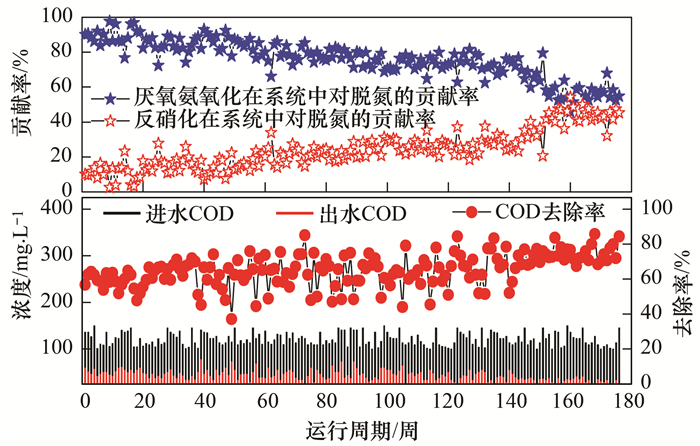
|
图 5 不同基质比下厌氧氨氧化和异养反硝化对脱氮的贡献率及COD的变化特征 Fig. 5 Characteristics of contributions of ANAMMOX and heterotrophic denitrification to nitrogen removal and the variation of COD in the system under different substrate ratios |
由图 5可知, 整个反应运行过程中, COD平均进水浓度为120.77 mg ·L-1, 其出水浓度随着进水NO2--N/NH4+-N的增大逐渐减小, 由最开始的58.70 mg ·L-1减小至30.50 mg ·L-1, 分析其原因, 主要是由于反应运行初期, 厌氧氨氧化反应占据优势, 异养反硝化较弱, 导致系统内COD降解速率较慢, 随着厌氧氨氧化反应逐渐地减弱, 异养反硝化增强, 导致COD降解速率加快.
2.4 典型周期内各基质的降解特性图 6表示典型周期(进水NO2--N/NH4+-N为1.4~1.6)内各基质的降解特性.典型周期结束后测得MLVSS浓度为2 570 mg ·L-1.从中可知, NH4+-N和NO2--N的降解过程均为零级反应, 线性关系良好, 比降解速率分别为0.404 mg ·(g ·h)-1和0.599 mg ·(g ·h)-1, 两者的比降解速率之比为1.48, 大于厌氧氨氧化反应的理论比值1.32, 说明反硝化菌与厌氧氨氧化菌竞争共同的反应底物NO2--N. 18 h之前, NO3--N的生成量为正值, 比生成速率为0.107 mg ·(g ·h)-1, 与NH4+-N的比降解速率之比为0.26, 说明在这段时间内, 反硝化菌的主要反应基质为NO2--N. 18 h之后, COD比降解速率增大, 反硝化不仅将发生厌氧氨氧化剩余的NO2--N反硝化, 且将生成的NO3--N也反硝化, 导致NO3--N的生成量为负值, 说明异养反硝化在系统中逐渐增强, 与刘常敬等[26]的研究结果相符.

|
图 6 典型周期内各基质的降解特性 Fig. 6 Degradation characteristics of substances in a typical cycle |
综上可知, 厌氧氨氧化和反硝化可实现协同脱氮除碳, 然而厌氧氨氧化和反硝化过程都消耗H+, 导致pH值升高, 这还需要进一步地研究.
3 结论(1) 本试验在温度为24℃, pH为7.2±0.2时, 考察不同进水基质比(NO2--N/NH4+-N)对厌氧氨氧化与反硝化耦合脱氮除碳的影响.当进水NO2--N/NH4+-N为1.4~1.6时系统脱氮除碳效果最佳, NH4+-N、NO2--N和COD平均出水浓度分别为2.14、1.07和30.50mg ·L-1, 去除率分别为93.62%、97.79%和74.75%, ΔNO2--N/ΔNH4+-N和ΔNO3--N/ΔNH4+-N分别为1.60和0.17.
(2) 在整个运行过程中, 厌氧氨氧化与异养反硝化协同脱氮除碳, 随着进水NO2--N/NH4+-N的增加, 系统内厌氧氨氧化对脱氮的贡献率逐渐减小, 异养反硝化对脱氮的贡献率逐渐增大.系统内厌氧氨氧化与异养反硝化存在竞争和协同关系, TN的去除是异养反硝化菌和厌氧氨氧化菌共同作用的结果.
(3) 典型周期内, 即系统脱氮效果最佳时, NO2--N和NH4+-N的降解过程均为零级反应, 两者线性关系良好, 比降解速率分别为0.404 mg ·(g ·h)-1和0.599 mg ·(g ·h)-1, 两者的比降解速率之比为1.48.
| [1] | Van De Graaf A A, De Bruijn P, Robertson L A, et al. Metabolic pathway of anaerobic ammonium oxidation on the basis of 15N studies in a fluidized bed reactor[J]. Microbiology, 1997, 143(7): 2415-2421. DOI:10.1099/00221287-143-7-2415 |
| [2] |
曹天昊, 王淑莹, 苗蕾, 等. 不同基质浓度下SBR进水方式对厌氧氨氧化的影响[J]. 中国环境科学, 2015, 35(8): 2334-2341. Cao T H, Wang S Y, Miao L, et al. Influence of feeding modes on ANAMMOX under different influent substrate concentration in SBR[J]. China Environmental Science, 2015, 35(8): 2334-2341. DOI:10.3969/j.issn.1000-6923.2015.08.011 |
| [3] |
姚俊芹, 周少奇. 厌氧氨氧化生物脱氮研究进展[J]. 化工学报, 2005, 56(10): 1826-1831. Yao J Q, Zhou S Q. Progress of biological nitrogen removal by anaerobic ammonium oxidation[J]. Journal of Chemical Industry and Engineering, 2005, 56(10): 1826-1831. DOI:10.3321/j.issn:0438-1157.2005.10.002 |
| [4] | Van Der Star W R L, Abma W R, Blommers D, et al. Startup of reactors for anoxic ammonium oxidation:experiences from the first full-scale anammox reactor in Rotterdam[J]. Water Research, 2007, 41(18): 4149-4163. DOI:10.1016/j.watres.2007.03.044 |
| [5] | Schmidt I, Sliekers O, Schmid M, et al. New concepts of microbial treatment processes for the nitrogen removal in wastewater[J]. FEMS Microbiology Reviews, 2003, 27(4): 481-92. DOI:10.1016/S0168-6445(03)00039-1 |
| [6] |
安芳娇, 彭永臻, 董志龙, 等. 不同运行策略下厌氧氨氧化的脱氮性能[J]. 环境科学, 2018, 39(6): 2770-2771. An F J, Peng Y Z, Dong Z L, et al. Performance of the removal of nitrogen during anaerobic ammonia oxidation using different operational strategies[J]. Environmental Science, 2018, 39(6): 2770-2771. |
| [7] | Fux C, Boehler M, Huber P, et al. Biological treatment of ammonium-rich wastewater by partial nitritation and subsequent anaerobic ammonium oxidation (anammox) in a pilot plant[J]. Journal of Biotechnology, 2002, 99(3): 295-306. DOI:10.1016/S0168-1656(02)00220-1 |
| [8] | Ahn Y, Hwang I, Min K S. ANAMMOX and partial denitritation in anaerobic nitrogen removal from piggery waste[J]. Water Science and Technology, 2004, 49(5-6): 145-153. DOI:10.2166/wst.2004.0748 |
| [9] | Tsushima I, Ogasawara Y, Kindaichi T, et al. Development of high-rate anaerobic ammonium-oxidizing (ANAMMOX) biofilm reactors[J]. Water Research, 2007, 41(8): 1623-1634. DOI:10.1016/j.watres.2007.01.050 |
| [10] | Jin R C, Xing B S, Yu J J, et al. The importance of the substrate ratio in the operation of the ANAMMOX process in upflow biofilter[J]. Ecological Engineering, 2013, 53: 130-137. DOI:10.1016/j.ecoleng.2012.12.027 |
| [11] |
闾刚, 徐乐中, 沈耀良, 等. 基质比对ABR厌氧氨氧化工艺脱氮性能的影响[J]. 环境科学, 2017, 38(5): 2006-2011. Lü G, Xu L Z, Shen Y L, et al. Effect of substrate ratio on nitrogen removal performance of ANAMMOX in ABR[J]. Environmental Science, 2017, 38(5): 2006-2011. |
| [12] |
陈永, 张树德, 张杰, 等. 亚硝酸盐氮浓度对厌氧氨氧化反应的影响[J]. 中国给水排水, 2006, 22(17): 74-76. Chen Y, Zhang S D, Zhang J, et al. Influence of nitrite nitrogen concentration on ANAMMOX process[J]. China Water & Wastewater, 2006, 22(17): 74-76. DOI:10.3321/j.issn:1000-4602.2006.17.020 |
| [13] |
张诗颖, 吴鹏, 宋吟玲, 等. 厌氧氨氧化与反硝化协同脱氮处理城市污水[J]. 环境科学, 2015, 36(11): 4174-4179. Zhang S Y, Wu P, Song Y L, et al. Nitrogen removal using ANAMMOX and denitrification for treatment of municipal sewage[J]. Environmental Science, 2015, 36(11): 4174-4179. |
| [14] | APHA. Standard methods for the examination of water and wastewater (21st ed.)[M]. Washington, DC: American Public Health Association, 2007. |
| [15] |
魏思佳, 于德爽, 李津, 等. 厌氧氨氧化与反硝化耦合脱氮除碳研究Ⅰ:COD/NH4+-N对耦合反应的影响[J]. 中国环境科学, 2016, 36(3): 759-767. Wei S J, Yu D S, Li J, et al. Simultaneous carbon and nitrogen removal by anaerobic ammonium oxidation and denitrificationⅠ:effect of COD/NH4+-N on coupled reaction[J]. China Environmental Science, 2016, 36(3): 759-767. DOI:10.3969/j.issn.1000-6923.2016.03.019 |
| [16] |
尤永军.游离氨(FA)对硝化菌活性的抑制影响试验研究[D].兰州: 兰州交通大学, 2015. You Y J. Study on the effect of free ammonia (FA) on the inhibition of nitrifying bacteria activity[D]. Lanzhou: Lanzhou Jiaotong University, 2015. http://www.wanfangdata.com.cn/details/detail.do?_type=degree&id=D702831 |
| [17] | Strous M, Heijnen J J, Kuenen J G, et al. The sequencing batch reactor as a powerful tool for the study of slowly growing anaerobic ammonium-oxidizing microorganisms[J]. Applied microbiology and biotechnology, 1998, 50(5): 589-596. DOI:10.1007/s002530051340 |
| [18] |
周凌, 操家顺, 蔡娟, 等. 低浓度氨氮条件下厌氧氨氧化反应器的启动研究[J]. 给水排水, 2006, 32(11): 34-37. Zhou L, Cao J S, Cai J, et al. Experimental study on startup of ANAMMOX reactor under low ammonia concentration[J]. Water & Wastewater Engineering, 2006, 32(11): 34-37. DOI:10.3969/j.issn.1002-8471.2006.11.009 |
| [19] |
安芳娇, 彭永臻, 张永辉, 等. 基质比对厌氧氨氧化脱氮性能的影响[J]. 环境科学学报, 2018, 38(3): 1010-1015. An F J, Peng Y Z, Zhang Y H, et al. Effect of substrate ratio on the performance of nitrogen removal through anaerobic ammonia oxidation[J]. Acta Scientiae Circumstantiae, 2018, 38(3): 1010-1015. |
| [20] | 李媛.厌氧氨氧化工艺启动和运行特性及其受抑机理研究[D].无锡: 江南大学, 2014. http://cdmd.cnki.com.cn/Article/CDMD-10295-1014370516.htm |
| [21] |
马斌.城市污水连续流短程硝化厌氧氨氧化脱氮工艺与技术[D].哈尔滨: 哈尔滨工业大学, 2012. Ma B. Nitritation and ANAMMOX achieved in continous reactors treating sewage[D]. Harbin: Harbin Institute of Technology, 2012. http://www.wanfangdata.com.cn/details/detail.do?_type=degree&id=D239073 |
| [22] |
安芳娇, 赵智超, 黄利, 等. HRT对厌氧氨氧化协同异养反硝化脱氮的影响[J]. 环境科学, 2018, 39(9): 4302-4309. An F J, Zhao Z C, Huang L, et al. Effect of HRT on nitrogen removal using ANAMMOX and heterotrophic denitrification[J]. Environmental Science, 2018, 39(9): 4302-4309. |
| [23] | Bipin K P, Kazama F, Saiki Y, et al. Presence and activity of anammox and denitrification process in low ammonium-fed bioreactors[J]. Bioresource Technology, 2007, 98(11): 2201-2206. DOI:10.1016/j.biortech.2006.08.014 |
| [24] | Chen H H, Liu S T, Yang F L, et al. The development of simultaneous partial nitrification, ANAMMOX and denitrification (SNAD) process in a single reactor for nitrogen removal[J]. Bioresource Technology, 2009, 100(4): 1548-1554. DOI:10.1016/j.biortech.2008.09.003 |
| [25] |
周少奇. 厌氧氨氧化与反硝化协同作用化学计量学分析[J]. 华南理工大学学报(自然科学版), 2006, 34(5): 1-4. Zhou S Q. Stoichiometric analysis of combined reaction of anaerobic ammonia oxidation with denitrification[J]. Journal of South China University of Technology (Natural Science Edition), 2006, 34(5): 1-4. DOI:10.3321/j.issn:1000-565X.2006.05.001 |
| [26] |
刘常敬, 李泽兵, 郑照明, 等. 厌氧氨氧化耦合异养反硝化的脱氮性能及污泥性状[J]. 环境工程学报, 2014, 8(8): 3137-3142. Liu C J, Li Z B, Zheng Z M, et al. Nitrogen removal performance and sludge characteristics of ANAMMOX coupling heterotrophic denitrification[J]. Chinese Journal of Environmental Engineering, 2014, 8(8): 3137-3142. |
 2018, Vol. 39
2018, Vol. 39


